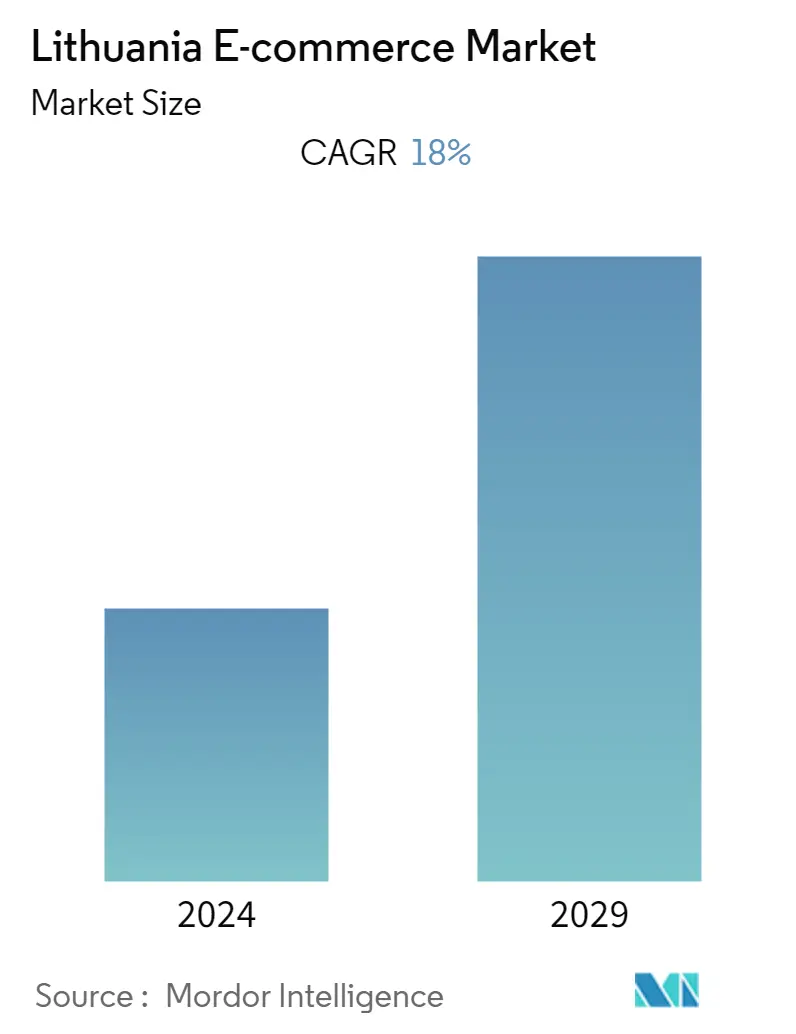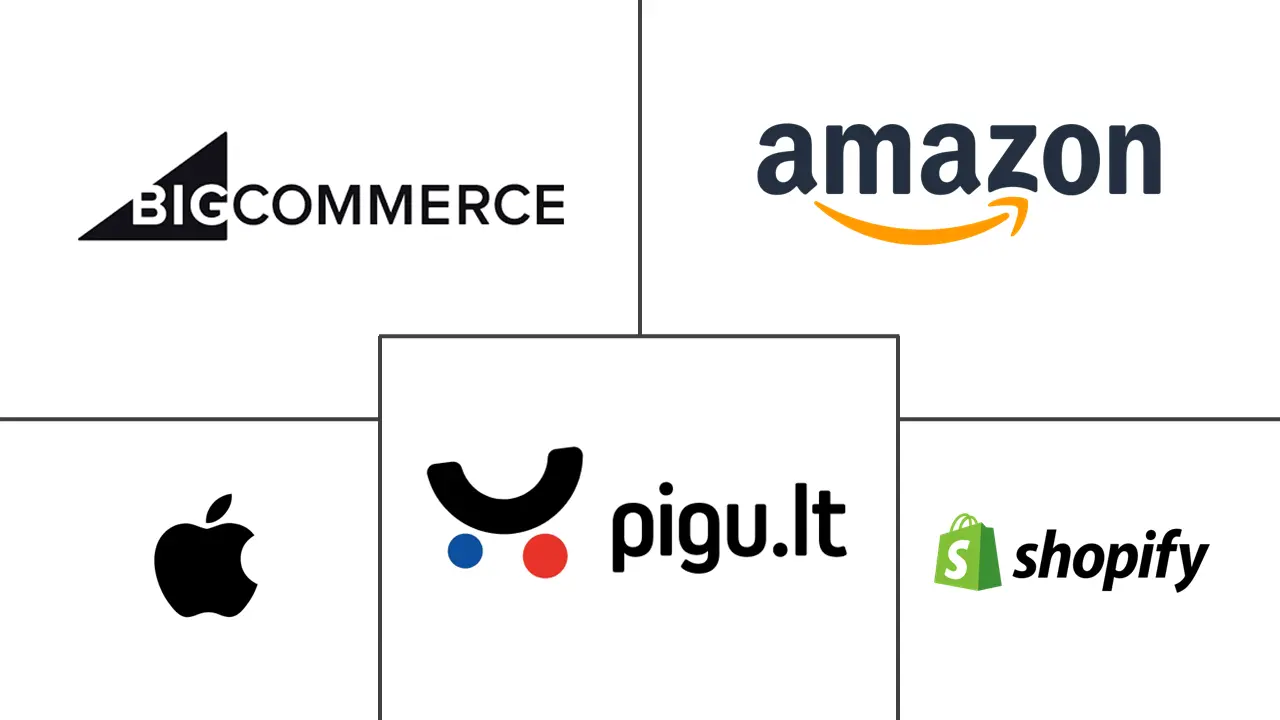
| Study Period | 2019 - 2029 |
| Base Year For Estimation | 2023 |
| Forecast Data Period | 2024 - 2029 |
| Historical Data Period | 2019 - 2022 |
| CAGR | 18.00 % |
| Market Concentration | Medium |
Major Players
*Disclaimer: Major Players sorted in no particular order |
Lithuania E-commerce Market Analysis
The Lithuania e-commerce market is anticipated to register a CAGR of 18% during the forecast period (2022- 2027). Despite the variations in the sales processes between B2B and B2C businesses, B2B customers can still have the same user experience as B2C customers, including online storefronts, interactions with chatbots instead of salespeople, online payment portals, and more. B2B clients benefit from the same convenience of online purchasing as B2C customers but with built-in capabilities that account for contract pricing, account hierarchies, and other distinctly B2B characteristics.
- In Lithuania, where e-commerce is prevalent, most online shoppers have made at least one purchase from an online business in their nation. However, a significant number of Lithuanians have purchased items from foreign websites. Due to Lithuania's small size, the populace occasionally lacks a range of items. Because purchasing power is reduced, Lithuanians are increasingly adopting electronic technologies, and virtual transactions are no longer a source of anxiety; successful purchases motivate people to do so even more. However, only a small percentage of these purchasers are long-term.
- Small businesses benefit from going online since they can readily compete with larger companies. When it comes to internet purchasing, it saves money because firms don't have to rent a storefront, and warehousing isn't usually required. It is considerably easier to reach overseas markets by trading online; there is no need to confine oneself to Lithuania. It's worth noting that online trading has a flip side. The major disadvantage of the online store is that users can't view the thing before they buy it. People who are making money are shopping online.
- According to Internation Trade Administration, Lithuania ranks one in the World Competitiveness Rankings for communication technology, and it is one of the EU's leading countries in information and communication technologies. It shows the EU's number of people aged 16 to 24 who have received formal ICT training. Lithuanians have the EU's quickest download and upload speeds. Lithuania leads the continent in terms of the density of public internet connection points. As a result, e-banking is used to complete 92% of all financial transactions. The most advanced ICT technologies (EDGE technology, mobile WiMAX 4G Internet, 3G mobile communications infrastructure, and so on) have been fully implemented and are being used across the country.
- The three-month quarantine in Lithuania prompted businesses to refocus and pay close attention to e-commerce, but it also influenced consumer behavior. According to a study of Lithuanians by Enterprise Lithuania, a non-profit agency under the Ministry of Economy and Innovation of Lithuania, every fifth person bought more than usual online during the quarantine, and roughly a fifth of those polled plan to continue buying more online. During this time, e-commerce in the Baltic States expanded by 80%, and consignment movements in Lithuania increased by 54%. The Entrepreneurship and Export Development Agency conducted a poll on the Lithuanian population.
- In December 2021, Lithuania collaborated with PChome, one of Taiwan's largest e-commerce platforms, to gain a foothold in the East Asian market. The Head of the Export Department at Enterprise Lithuania has stated that this collaboration is expected to support the E-commerce market in the country. The Baltic nation's enterprises are connected to PChome, while related negotiations and logistical concerns are being resolved and anticipated to be completed in the spring.
- In April 2022, Ministers of the Economy and Innovation, as well as the Minister of National Defense, have written to ministers from other European Economic Area countries, urging them to join the Lithuanian initiative, which aims to persuade Apple and Google to remove Yandex apps from European e-commerce platforms. These Russian apps for online passenger transportation service booking represent a risk to personal data security.
Lithuania E-commerce Industry Segmentation
Conducting an e-commerce business means fostering relationships and selling information, services, and goods over computer communication networks. E-commerce usually refers to trading goods and services over the internet, which means broader economic activity. E-commerce consists of B2B and B2C and internal organizational transactions that support these activities.
The study also tracks the key market parameters, underlying growth influencers, and major vendors operating in the industry, which supports the market estimations and growth rates over the forecast period in Lithuania. The study further analyzes the overall impact of Covid-19 on the ecosystem. The scope of the report encompasses market sizing and forecast for segmentation by B2B and B2C, in which the B2C channel is further segmented by application.
| Market size (GMV) for the Period of 2017-2027 | |
| Market Segmentation - by Application | Beauty and Personal Care |
| Consumer Electronics | |
| Fashion and Apparel | |
| Food and Beverage | |
| Furniture and Home | |
| Others (Toys, DIY, Media, etc.) |
| Market size for the Period of 2017-2027 |
Lithuania E-commerce Market Size Summary
The Lithuania e-commerce market is experiencing significant growth, driven by advancements in information and communication technologies and increased internet penetration. The market is characterized by a robust adoption of online shopping, with both B2B and B2C sectors benefiting from enhanced user experiences through online storefronts and payment portals. The small size of the country has led to a high number of consumers purchasing from foreign websites, as local options can be limited. The COVID-19 pandemic further accelerated the shift towards e-commerce, with many consumers increasing their online purchases during lockdowns. This shift has encouraged small businesses to establish an online presence, allowing them to compete with larger companies and reach international markets without the need for physical storefronts.
Lithuania's strong mobile connectivity and the rollout of 5G technology are expected to further boost the e-commerce sector by providing faster and more reliable internet services. The country's high mobile penetration rate facilitates easy access to e-commerce platforms, enhancing the shopping experience for consumers. Collaborations with international e-commerce platforms, such as the partnership with PChome, aim to expand Lithuania's market reach into East Asia. Additionally, innovations like the Futugo app and new e-commerce hubs in cities like Kaunas are set to transform the online shopping landscape, integrating digital and physical shopping experiences. As the market continues to evolve, the competition is intensifying, with major players and startups alike striving to capture a larger share of the growing e-commerce market in Lithuania.
Lithuania E-commerce Market Size - Table of Contents
1. MARKET DYNAMICS
-
1.1 Market Drivers
- 1.1.1 Increase developments of 5G Technology
- 1.1.2 Increased Adoption of Smartphones
-
1.2 Market Challenges
- 1.2.1 Data Security
- 1.3 Analysis of Key Demographic Trends and Patterns Related to E-commerce Industry in Lithuania (Coverage to include Population, Internet Penetration, ecommerce Penetration, Age & Income etc.)
- 1.4 Analysis of the Key Modes of Transaction in the E-commerce Industry in Lithuania (coverage to include prevalent modes of payment such as cash, card, bank transfer, wallets, etc.)
- 1.5 Analysis of Cross-border E-commerce Industry in Lithuania (Current market value of cross-border & key trends)
- 1.6 Current Positioning of Lithuania in the E-commerce Industry in the Region
2. Market Segmentation
-
2.1 By B2C E-commerce
- 2.1.1 Market size (GMV) for the Period of 2017-2027
- 2.1.2 Market Segmentation - by Application
- 2.1.2.1 Beauty and Personal Care
- 2.1.2.2 Consumer Electronics
- 2.1.2.3 Fashion and Apparel
- 2.1.2.4 Food and Beverage
- 2.1.2.5 Furniture and Home
- 2.1.2.6 Others (Toys, DIY, Media, etc.)
-
2.2 By B2B E-commerce
- 2.2.1 Market size for the Period of 2017-2027
Lithuania E-commerce Market Research FAQs
What is the current Lithuania E-commerce Market size?
The Lithuania E-commerce Market is projected to register a CAGR of 18% during the forecast period (2025-2030)
Who are the key players in Lithuania E-commerce Market?
Amazon.com Inc, Pigu.lt, Apple Inc, Shopify and BigCommerce are the major companies operating in the Lithuania E-commerce Market.


